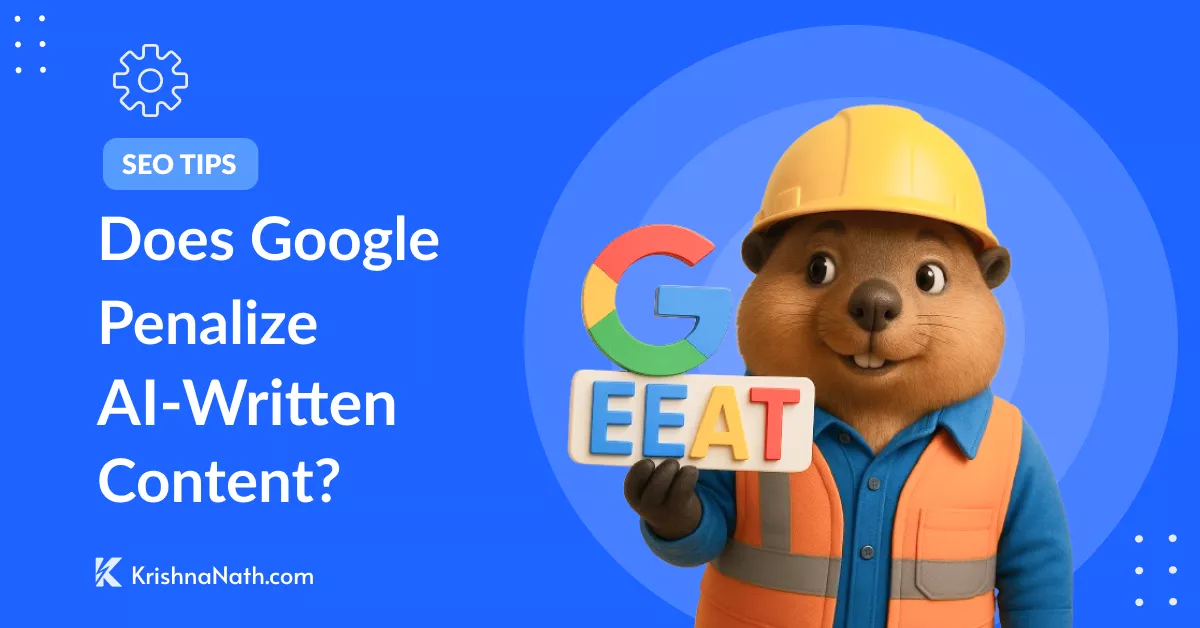Imagine you’re chilling with a slice of pizza and prompting on ChatGPT.
Within seconds—boom —a dozen blog posts appear. 💥
You published that AI-generated content on your blog. Then, you went for a vacation with your beloved.
A month later, you came back home and—bang!—your articles were ranking in Google’s top spots, earning you $10,000.”
Immediately, you called your beloved and got married. A happy life. Your AI-generated content kept making thousands of dollars a month.
Possible? Can AI-generated content make thousands of dollars, or does it get penalized by Google?
Want to know? Read this short piece just written for you.
Google Search’s guidance about AI-generated content
First, let’s look at what AI-generated content is and why it could be a problem.
AI-generated content refers to any type of content, including text, image, video, and audio, created by artificial intelligence software.
In writing, people use several popular softwares to create AI-generated text content. Some popular tools are ChatGPT, Deepseek, Jasper, and Copy.ai.
These tools use natural language processing (NLP) and machine learning models like GPT to generate human-like text. They scan large amounts of data to understand context and give relevant answers.
Now, the question you could ask: If AI can produce human-like text, what is the problem with it?
Let’s find out.
Problems with AI-generated content
See, in 2025, AI is quite capable of answering any query on any topic with the latest version of GPT (like GPT-4).
That said, being a machine, it lacks real understanding and makes factual errors. This causes many minor to major issues when producing content.
Here are some of those.
- Quality and Originality Issues
Normally, AI models like GPT-4 are trained on massive datasets.
Guess what happens when everyone trains their models on the same data?
They often produce copied and flat content that sounds robotic, brings no fresh perspective, and has no unique brand voice.
Not only that, sometimes it copies and pastes the same data from original sources.
All these drawbacks can cause many potential issues:
- Google may rank your site lower if it detects duplicate content.
- If plagiarized content is used to manipulate rankings, Google may take manual actions.
- Publishing content without permission from the original sources could damage your site’s credibility.
- Though Google doesn’t penalize duplicate content, it may push your content down by favouring the original one.
- Bias Information
As a human, you’ve got a powerful combo—prefrontal cortex and cognitive flexibility—that helps you think logically, adapt, and weigh decisions.
What about AI tools?
They don’t come with these perks.
They don’t have a prefrontal cortex, emotional depth, or true adaptability.
That’s why AI can make mistakes—especially when faced with ethical judgment and incomplete data.
For instance, a study of 6 AI models analyzing 120 facts found wide variations in fact-checking accuracy.
- Originality.ai shows the highest accuracy at 72.3% with a low 1.7% error rate and no unknowns.
- GPT-4 has 64.9% accuracy and no errors, but often avoids judgment with a 34.2% unknown rate.
- Llama-2-70b has 62.5% accuracy, a 3.3% error rate, and gives definitive answers without unknowns.
So, AI can provide biased data, misinformation, and wrong facts that can mislead your audience.
And, this is concerning because Google is quite strict about misleading content.
Here is what they say about it:
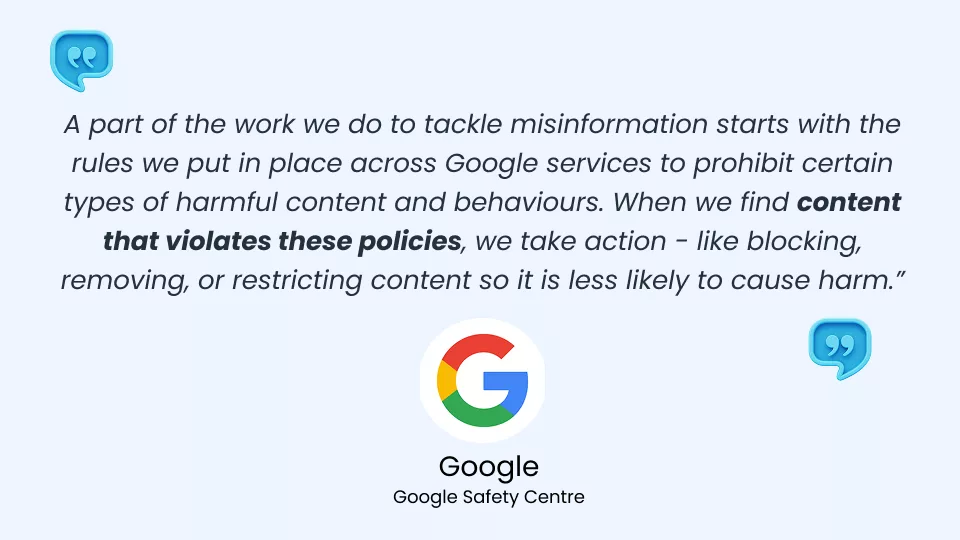
- Lack of Emotional Nuances:
Let me ask you a question.
If you’re trying to lose weight and get ripped, who would you rather trust—
A robot spitting out fitness tips? Or a real doctor with decades of experience, who treats you like a friend?
Definitely, a real doctor.
The same thing happens with content.
Here are some issues with AI-generated content:
- It feels impersonal, overly formal, filled with technical jargon,
- It lacks personal connection, brand voice, humor, storytelling, and engagement
- It overly optimises any answers with limited words, making the output fluffy and repetitive.
- It lacks depth, insights, current data, case studies, expert opinions, and a personal touch.
- Technical Issues
AI-generated content is either not optimized or overly optimized with keyword stuffing.
Not only that, AI tools can’t naturally add real-world experience or author insights, which is a major factor for higher ranking.
Therefore, AI content that is stuffed with keywords with no real value misses the mark to satisfy Google and violates the people-first content policy.
As you can see, AI-generated content has several issues and needs heavy editing.
Now, let’s see how Google tackles these issues.
How Google deals with AI-generated content
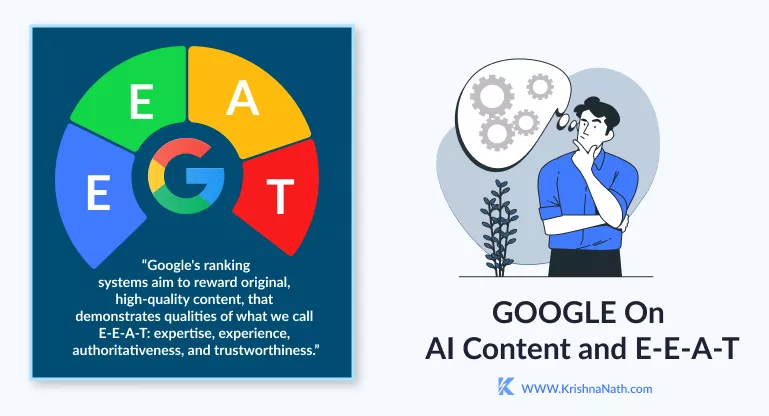
Google rolled out its first official guidance on AI-generated content on February 8, 2023.
They say,
“Google’s ranking systems aim to reward original, high-quality content that demonstrates qualities of what we call E-E-A-T: expertise, experience, authoritativeness, and trustworthiness. Our focus is on the quality of content, rather than how content is produced.”
As you can see on the Google Search Central blog, Google recognized the use of AI assistant tools and how automation can help creators create helpful content.
Also, Google has rolled out many updates and policies on AI-generated content.
Let’s see all those in short
- Feb 8, 2023 – Official AI content guidance
Google has made it clear that AI-generated content is fine if it aligns with the E-E-A-T (Experience, Expertise, Authoritativeness, Trustworthiness) principles.
- Sep 14 – 28, 2023 – Helpful Content Update
This update targeted low-quality AI-generated content, emphasizing “people-first” content.
This update mainly targeted spam and low-quality content rather than explicitly targeting AI-generated articles or “parasite SEO.”
Scaled content abuse (which could include AI spam) was solved, but things like using “expired domains” for AI content are just guesses.”
A broad spam update focused on refining search quality. It improved Google’s ability to detect and demote spammy content, including AI-generated spam.
- Jul 31, 2024 – Address Explicit Fake Update
Google made its existing spam and deceptive content policies stronger to better detect and demote:
- AI-generated fake news (unlabeled misinformation).
- Deep fake images, videos are used for manipulation.
- AI voice clones in spam or scam content.
Google pays no attention to how the content is being generated
As Google reported, they will be pushing that specific content higher on the SERP that holds depth and truly meets what the audience is looking for.
In a single term, meeting users’ search intent.
That’s why human-written content won’t rank well if,
- It fails to answer the user’s query clearly and completely.
- It focuses only on keywords or word count instead of being genuinely helpful.
- It lacks structure or clarity, making users leave quickly.
- It’s hard to scan or poorly formatted, even if the information is expert-level.
- It includes fluff or filler instead of satisfying the user’s search intent.
In fact, AI-generated content has been around long before ChatGPT became a household name.
Google has been dealing with automated content for years now, and its systems have gotten better at checking content quality, whether it’s human-written or AI.
Here’s the list of AI models and tools before ChatGPT:
- Pandorabots – 2008, developed by Pandorabots, Inc.
- IBM Watson – 2011, developed by IBM
- Mitsuku / Kuki – 2013, created by Steve Worswick
- Google Smart Reply – 2015, developed by Google
- Seq2Seq – 2014, developed by Google Brain
- Transformer – 2017, developed by Google Brain
- BERT – 2018, developed by Google AI
- GPT – 2018, developed by OpenAI
- Replika – 2017, created by Luka, Inc.
- AI Dungeon – 2019, developed by Latitude
- Hugging Face Transformers – 2019, developed by Hugging Face
- Inferkit – 2020 (beta release), developed by Inferkit
This means Google is fine with AI-generated content—as long as it’s people-first and shows clear signs of expertise, experience, authority, and trust (EEAT).
But what is EEAT here?
Let’s learn more about this guideline.
What is EEAT: The Quality Rater Guideline by Google?
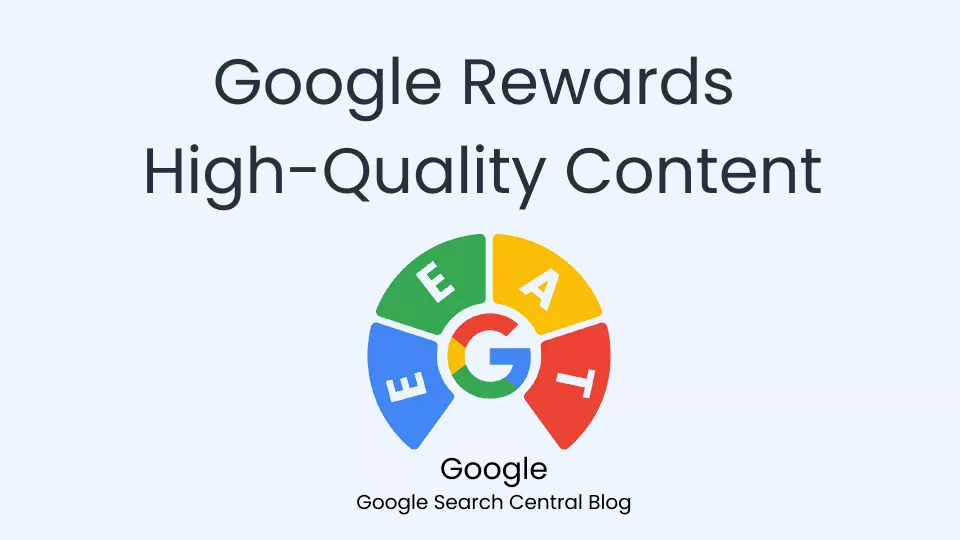
In recent years, Google has been using automatic ranking systems to a large degree.
This framework typically uses many different factors to measure quality and rank people-first content.
One of those major factors is EAT, which stands for Expertise, Authoritativeness, and Trustworthiness.
The E-A-T principle was introduced in Google’s Quality Rater Guidelines in 2014 to tackle low-quality content like content farms and medical misinformation.
Back in the early 2010s, many sites exploited Google’s algorithm by mass producing keyword-stuffed content to manipulate search and rank high.
Fast forward to December 15, 2022, and Google expanded the concept by adding another “E” for Experience, evolving E-A-T into E-E-A-T to better evaluate content based on real-life, first-hand knowledge.
Google reports;
“Now to better assess our results, E-A-T is gaining an E: experience.”
It means now you need to have real “experience” – whether it is using a product or visiting a place, or sharing personal expertise.
This is important for bloggers, review sites, and topics related to YMYL (Your Money or Your Life), where trustworthiness is crucial.
This framework helps Google spot the trustworthiness a content brings, which is the core pillar as defined in the Search Quality Rater Guidelines.
Example of E-E-A-T

Let’s compare these two pieces of content from a food blog: Before vs. After applying E-E-A-T.
- Title: “10 Best Restaurants in Paris”: ❌ Weak (No Experience Shown)
Content:
- Lists popular restaurants from TripAdvisor.
- No personal visits, just aggregated info.
- No photos, no personal anecdotes.
SEO Impact: - Thin content, likely outranked by more authoritative sites.
- High bounce rate (users don’t trust it).
- Title: “I Ate at 15 Paris Restaurants—Here Are the 10 Best”:✅ Strong (Shows Experience)
Content:
- Personal stories: “The duck confit at Le Comptoir was so tender, I went back twice!”
- Original photos/videos from visits.
- Comparisons based on real meals (not just Googled reviews).
SEO Impact: - Higher dwell time (users engage longer).
- More backlinks (other sites reference it as a trustworthy guide).
- Ranks better because Google sees real expertise + experience
What’s your thought? Which one will satisfy the users the most?
You know the answer.
What are Search Quality Raters, and how do they work?
As Google says, they are always working on improving their search experience through many experiments.
Search Quality Raters is one of those ways.
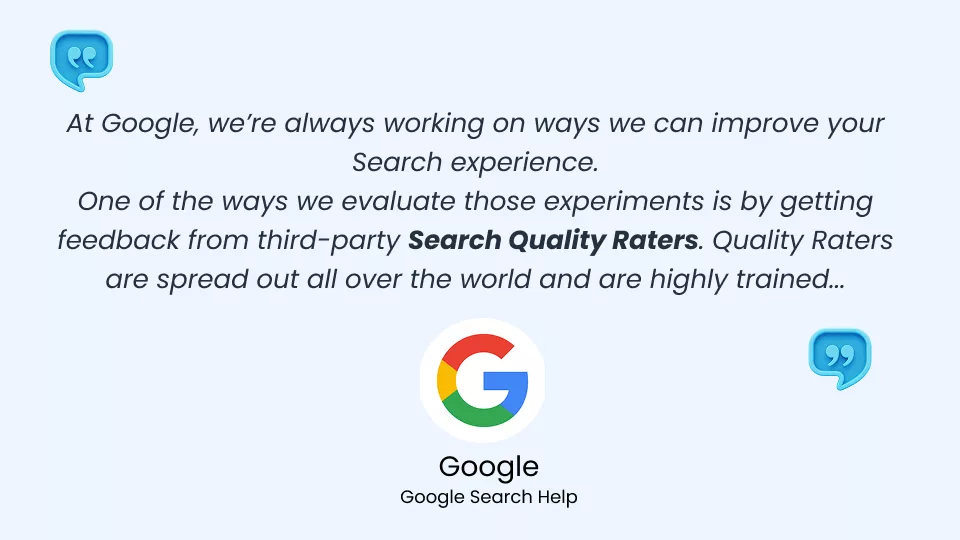
Here, Google has employed highly trained evaluators who are distributed all over the world and skillfully use Google’s extensive guidelines.
Google’s quality raters work by:
- Comparing search result sets to review relevance and usefulness.
- Rating individual page quality based on expertise, authority, and trustworthiness.
- Providing detailed feedback to refine Google’s ranking algorithms.
- Evaluating user experience by analyzing factors like readability and usability.
- Helping improve search accuracy by identifying gaps in results.
Why is E-E-A-T Important for SEO?
These days, every marketer and blogger seems to have front-row seats in the AI content circus. And, trust me, the buzz is louder than ever.
Regardless of anything, Google always tries to reward quality content, which is why Google has preferred
- Human experience (something AI can’t fake yet).
- Real-world testing (not just paraphrased info).
- Established authority (brands with a reputation).
This is where the E-E-A-T framework comes into play. Let’s deep dive into this.
1. E for Experience
Definition:
Experience refers to the content creator’s direct, personal experience with the topic.
Example:
A dentist writing about cavities, gum disease, and other dental problems.
Or a blogger like me writing about blogging, SEO, content writing jobs, and finding clients on LinkedIn.
Why it matters:
Google loves content created by individuals who have firsthand experience, not just theoretical knowledge.
2. E for Expeties (E)
Definition: Expertise refers to the depth of knowledge, skill, or qualification on a subject that a content creator has.
Why it matters: Google wants to present trustworthy content to its audience. That’s why they prefer content written by experts.
Example:
An expert digital marketer like Neil Patel is teaching email marketing.
3. A for Authoritativeness (A)
Definition:
Authoritativeness measures the reputation of the content author or the website. Google determines this factor through backlinks, industry recognition, and being linked to by the experts in the niche.
Why it matters
Google ranks authoritative sources higher because they are seen as reliable.
Example:
Government websites (.gov) for legal/health topics, like the CDC. It is a U.S. federal agency under the Department of Health and Human Services (HHS), which is one of the most trusted sources for public health research.
4. T for Trustworthiness (T)
Trustworthiness reflects the reliability and credibility of the content. Generally, Google assesses it through some factors like website security (HTTPS), user reviews, transparency about authorship, and overall site reputation.
Why it matters:
Google gives favours to content that is trustworthy, especially in industries where misinformation can have serious consequences (e.g., health, finance).
Also, websites with a history of providing accurate, honest, and well-researched information are more likely to rank well.
Example:
Clear sourcing of facts. No deceptive ads or affiliate links.
Pocket Note
Google has made it clear many times that E-E-A-T (Expertise, Experience, Authoritativeness, Trustworthiness) is not a direct ranking factor. It means there’s no “E-E-A-T score” in the algorithm.
But here is the thing: Google uses other ranking signals that indirectly measure E-E-A-T, especially for high-stakes topics (YMYL).
Google says:
“For example, our systems give even more weight to content that aligns with strong E-E-A-T for topics that could significantly impact the health, financial stability, or safety of people, or the welfare or well-being of society. We call these “Your Money or Your Life” topics, or YMYL for short.”
Use of AI for Content Creation and Success Story
As you read the report, Google is strongly recognising the power of AI and its ability to offer deep insights about any topic.
And, Google is right to say this.
If you are a writer, you know how many hours it takes just to brainstorm ideas and research topics. Then, outline creation, writing, optimising, and other things.
But guess what? With AI, you can save 80% of your time.
Read the story of Mickey Anderson.
Mickey Anderson, The Marketing Closer, faced challenges in creating 90-day campaigns, struggling with time-consuming content creation.
By using BrandWell, an AI-powered content marketing platform, she automated content generation, cutting campaign creation time by 80% and reducing her team size from three writers to one.
This led to a
- 60% decrease in labor costs,
- saving 5-10 hours per week, and
- boosting profit margins by 30%.
So, AI can be a game-changer for content creation—when used smartly with human inputs, as seen in Mickey Anderson’s success story.
In a nutshell
AI tools are like a sous chef for a cook—they handle the prep work and assist with the heavy lifting, but the chef still creates the dish and adds their unique flair.
Like, this chef metaphor idea is taken from ChatGPT, not fully mine.
So, instead of just reusing outdated, AI-generated content and republishing it on Google, you should use AI tools to enhance your research by adding current industry trends and updates.
This practice makes content more value-added, which Google loves to rank.

